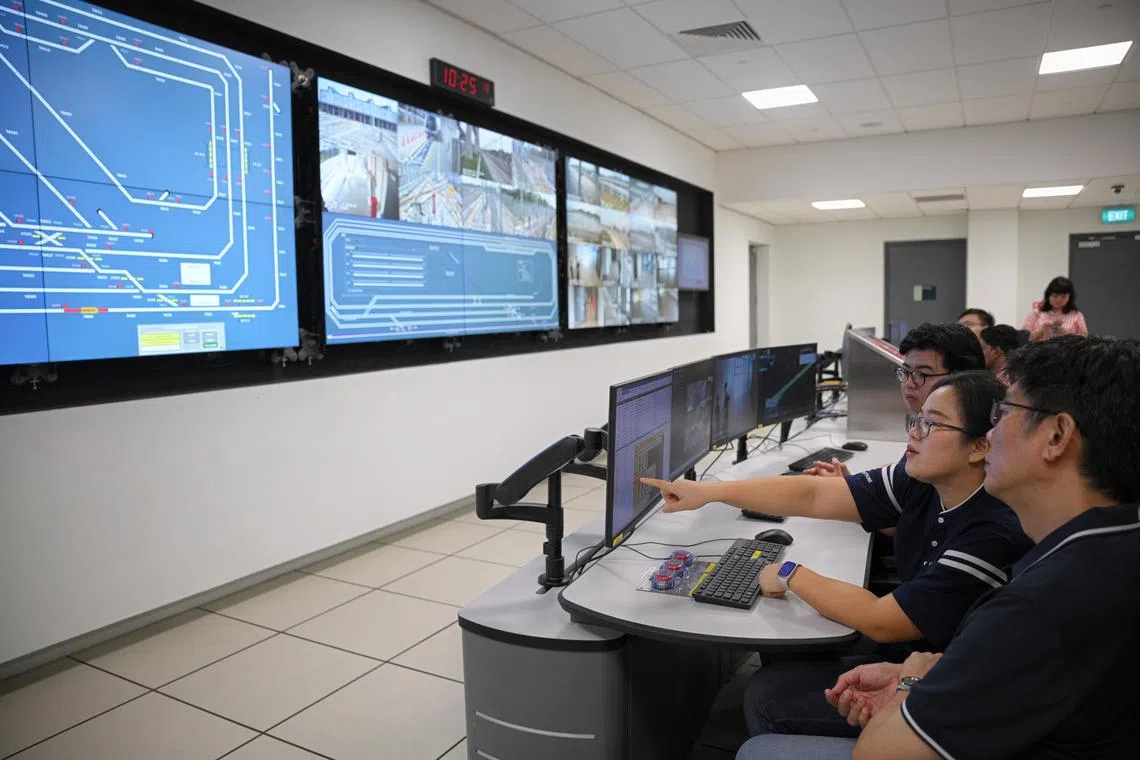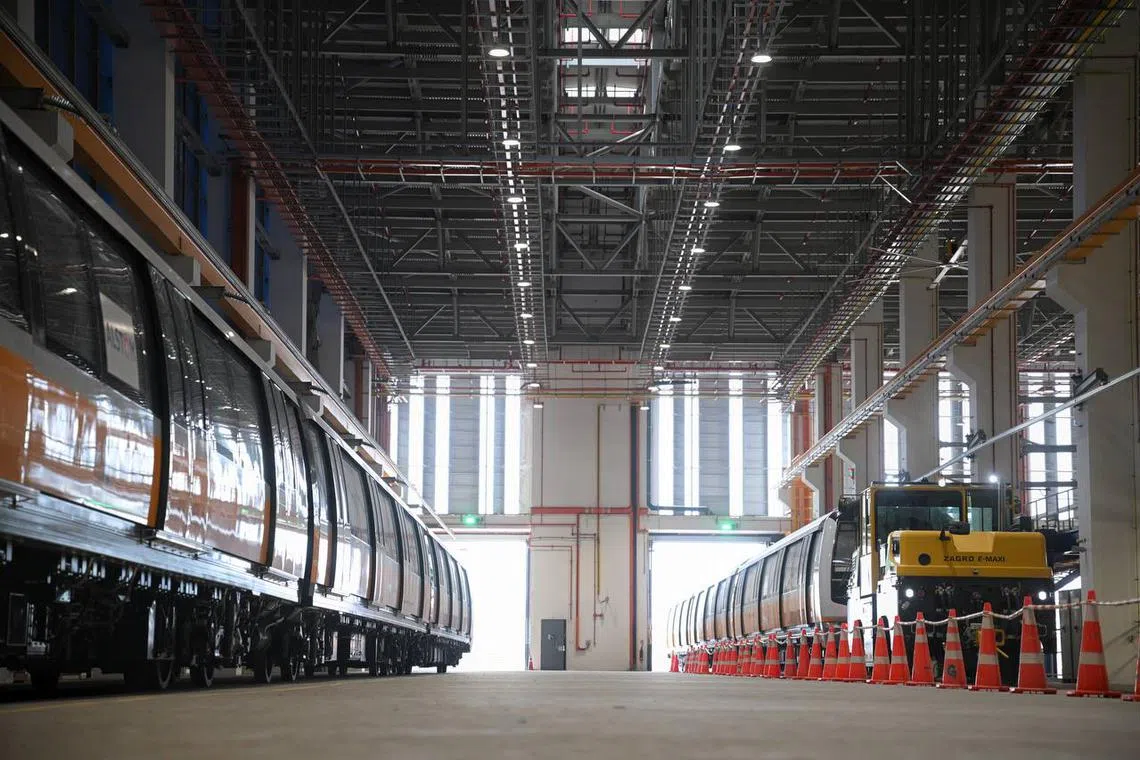$800m rail test centre opens, allows trains and rail systems to be tested in Singapore
Sign up now: Get ST's newsletters delivered to your inbox

SRTC houses a three-storey building with an operations control centre (above), administration offices and workshops, as well as inspection and maintenance areas.
ST PHOTO: MARK CHEONG
Follow topic:
SINGAPORE – Trains and rail systems can now be tested in Singapore, with the completion and opening of an $800 million test centre in Tuas.
Opened on March 28, the Singapore Rail Test Centre (SRTC) will allow the transport authorities and rail operators to carry out testing without depending on overseas facilities nor taking up limited engineering hours on the rail network, said the Land Transport Authority (LTA).
With the completion of the second and final phase of construction works, two more test tracks are now ready.
One is a 2.8km performance and integration test track with an S-shaped section, to assess if a train is well integrated with other rail systems. This is done by installing rail systems, including signalling and communication systems, onto the train to see if these can run smoothly, before testing is carried out later on actual rail lines. The S-shaped section is used to test a train’s turning capabilities.
The other track is a 3km endurance test track, with a 500m segment that has an uphill gradient of 3 per cent to simulate actual track conditions on operational rail lines here.
The endurance test track will be used to check if a train remains reliable after travelling for a specific mileage. Trains typically need to run about 1,000km before entering service.
Once a viaduct link between the East-West Line’s Tuas West Extension and SRTC is completed in 2029, trains can enter the centre via the extension. Before that, the trains will be transported into the centre by road via trailers.
SRTC also houses a three-storey building with an operations control centre, administration offices and workshops, as well as inspection and maintenance areas to support the midlife upgrading of trains.
As part of the first phase of works completed in November 2023, a 2.8km high-speed test track allows trains to be tested at speeds of up to 100kmh. Trains can run at maximum speeds on this track, which is designed with minimal curves and gradients, to assess traction and braking abilities.

A Road Rail Vehicle (right) tows a train which underwent testing back to the workshop at the SRTC on March 28.
ST PHOTO: MARK CHEONG
To enable testing of different MRT trains and systems, the high-speed test track is also equipped with different power supply systems. It has both the third rail, which runs along the tracks, and overhead conductor rail power systems.
The North East Line and upcoming Cross Island Line use an overhead conductor rail power system, while the other lines here use the third rail.
At present, the trains that will be tested at SRTC are 23 new ones that will ply the upcoming Stage 6 of the Circle Line (CCL), which will open in the first half of 2026.
The new trains have been assessed and commissioned at the centre since November 2023, LTA said.
From the completion of the first phase of construction in November 2023 to now, SRTC has clocked around 3,000 hours of testing on the high-speed test track.

Trains and rail systems can now be tested in Singapore, with the completion and opening of a new $800 million test centre in Tuas.
PHOTO: LTA
CCL Stage 6 will close the loop for the line, connecting the HarbourFront and Marina Bay stations.
The fully completed centre can now test a maximum of six trains – two per test track – at any time.
Construction on the centre began in 2021. It was originally set for completion in 2024 but was delayed by a year because of the Covid-19 pandemic.
Speaking at SRTC’s opening ceremony on March 28, Senior Minister of State for Transport Amy Khor said rigorous and thorough testing has become even more critical with the growth of Singapore’s rail network.
Before the centre’s development, there was a heavy reliance on overseas facilities to test new trains and systems before they were deployed in Singapore.
“While these facilities have served us well, they have been unable to fully replicate our local operating conditions. For instance, just our weather alone is very different from that of our major vendors in Europe and China,” she added.

Senior Minister of State for Transport Amy Khor at the SRTC’s opening ceremony on March 28.
ST PHOTO: MARK CHEONG
The testing, said LTA, also took up limited engineering hours on Singapore’s operational rail network.
Dr Khor noted that the completion of SRTC has given Singapore a purpose-built testing facility that will relieve pressures on the expansion and maintenance of its rail network.
It would free up more engineering hours for regular maintenance, helping to ensure continued service reliability, she added.
Besides allowing for round-the-clock testing at a dedicated facility away from residential areas, SRTC will play a strategic role in developing Singapore’s rail expertise, said Dr Khor.
It can deepen the capabilities of Singapore’s rail workforce through practical training options, in addition to providing a platform for research and development that original equipment manufacturers and industry partners can tap to test new technologies.
SRTC can also serve as a regional centre for rail testing, she added, enabling greater collaboration between local rail engineers and their regional counterparts.
Originally mooted in 2019, SRTC was constructed to support the authorities’ upgrading and expansion of the rail network, in addition to improving rail reliability, without affecting daily operations.
The centre is expected to free up limited engineering hours and reduce the need for line closures.



